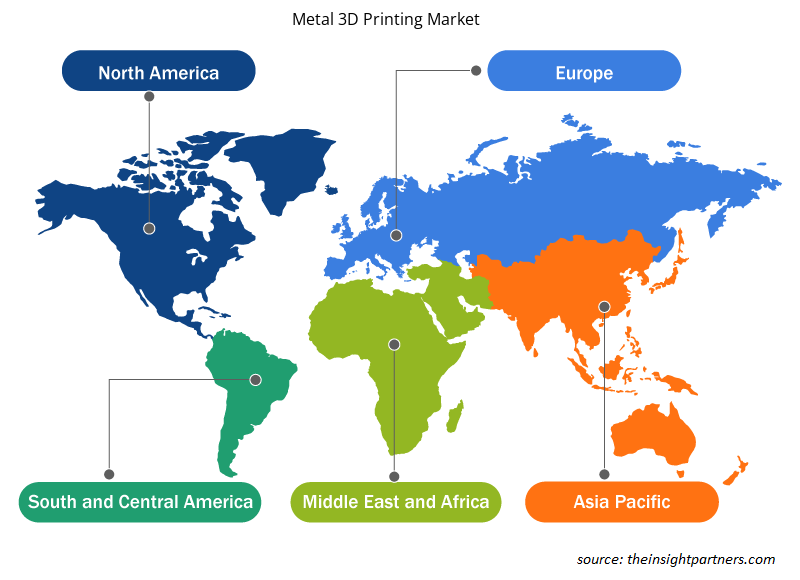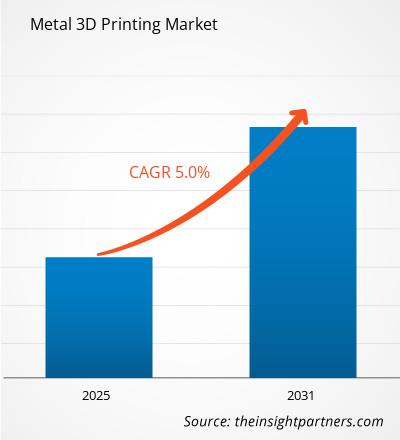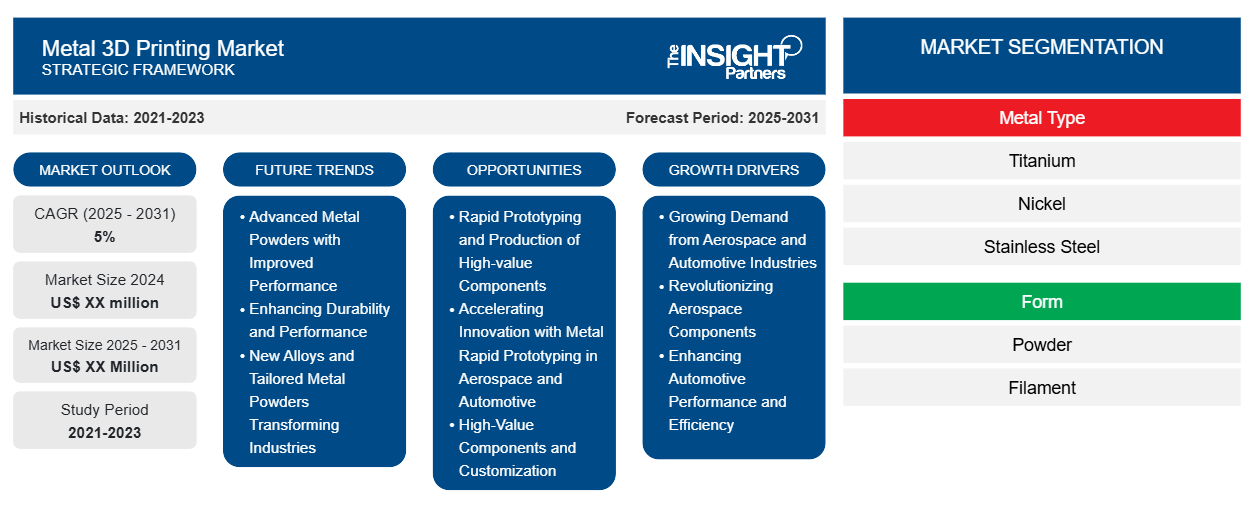预计金属 3D 打印市场在 2023 年至 2031 年期间的复合年增长率为 5%,市场规模将从 2023 年的 XX 百万美元扩大到 2031 年的 XX 百万美元。
报告按金属类型(钛、镍、不锈钢、铝等)细分。报告进一步根据形式(粉末、长丝等)进行分析。根据最终用途,报告细分为(航空航天和国防、汽车、医疗、建筑等)。全球分析进一步细分为区域和主要国家。报告以美元为单位提供上述分析和细分的价值。
报告目的
The Insight Partners 发布的《金属 3D 打印市场》报告旨在描述当前形势和未来增长、主要驱动因素、挑战和机遇。这将为各种业务利益相关者提供见解,例如:
- 技术提供商/制造商:了解不断变化的市场动态并了解潜在的增长机会,从而能够做出明智的战略决策。
- 投资者:对市场增长率、市场财务预测以及整个价值链中存在的机会进行全面的趋势分析。
- 监管机构:监管市场政策和警察活动,旨在最大限度地减少滥用行为,维护投资者的信任和信心,维护市场的完整性和稳定性。
金属3D打印市场细分
金属类型
- 钛
- 镍
- 不锈钢
- 铝
形式
- 粉末
- 灯丝
最终用途
- 航空航天和国防
- 汽车
- 医疗的
- 建造
地理
- 北美
- 欧洲
- 亚太
- 南美洲和中美洲
- 中东和非洲
地理
- 北美
- 欧洲
- 亚太
- 南美洲和中美洲
- 中东和非洲
定制此报告以满足您的需求
您可以免费定制任何报告,包括本报告的部分内容、国家级分析、Excel 数据包,以及为初创企业和大学提供优惠和折扣
-
获取此报告的关键市场趋势。这个免费样品将包括数据分析,从市场趋势到估计和预测。
金属 3D 打印市场增长动力
- 航空航天和汽车行业需求不断增长:航空航天和汽车行业是金属 3D 打印市场对轻量化和复杂零件制造解决方案增长的主要推动力。这两个行业都致力于减轻重量,以提高燃油经济性、性能和排放。金属 3D 打印可以减轻重量,创造出复杂的设计。
- 革命性的航空航天部件:金属 3D 打印改变了航空航天部件的格局,例如涡轮叶片、支架和其他结构部件。传统制造方法限制了设计,但增材制造使用复杂的几何形状,通常可以在不影响强度的情况下减轻重量。因此,新方法使飞机运行得更好,效率更高,进而推动了市场增长。
- 提高汽车性能和效率:同样,汽车行业也正在通过金属 3D 打印生产轻量化和高性能部件。制造商使用的大多数材料(如钛、铝和不锈钢)可生产出非常高效的部件,这些部件经久耐用但设计复杂。这些材料将提高燃油经济性和操控性,从而增加汽车制造对金属 3D 打印技术的需求。
金属3D打印市场未来趋势
- 性能更佳的先进金属粉末:高性能先进金属粉末是推动金属 3D 打印市场增长的未来趋势之一。此类粉末甚至具有更优异的性能,如强度、耐热性和耐腐蚀性。此类先进材料对于 3D 打印应用越来越必不可少,因为这些应用涉及生产必须承受多种使用条件并需要更高耐用性和高性能标准的组件的行业。
- 提高耐用性和性能:先进的金属粉末能够制造出能够承受极端条件(如航空航天和汽车等行业的极高温度和机械应力)的部件。它能够打印出更轻、更坚固、性能更佳的部件,从而直接提高发动机、涡轮机和车辆结构中关键部件的效率和寿命;这也推动了市场的增长。
- 新型合金和定制金属粉末改变行业:新型合金和定制金属粉末的开发也推动了医疗设备和工具等行业的铁创新。这些“奇特”材料可以创造真正前所未有的复杂几何形状,其特性针对特定应用进行了优化 - 植入物的即时生物相容性 - 或工业工具的更高硬度。客户对个性化和高品质的要求越高,先进金属粉末在 3D 打印中的应用速度就越快或越高。
金属 3D 打印市场机遇
- 快速成型和高价值部件生产:快速成型和高价值部件制造极大地推动了金属 3D 打印市场的发展。原型生产不断缩短各行业的设计测试周期、开发时间和制造流程。在航空航天、汽车和医疗设备等关键领域尤其如此。
- 利用金属快速成型技术加速航空航天和汽车行业的创新:在航空航天和汽车制造业中,金属快速成型技术对于加快创新周期至关重要。在快速成型技术中,工程师可以快速迭代设计并通过测试进行调整,然后缩短上市时间。结果是加快了开发速度,通过改进设计提高了准确性,并生产出性能更好、成本效益更高的组件——所有这些都增加了对金属 3D 打印相关技术的需求。
- 高价值部件和定制:该市场增长的另一个驱动力是涡轮叶片、发动机部件和相当复杂的医疗植入物的高价值部件制造。这种高性能和复杂几何部件只有金属 3D 打印才能实现,无法使用传统工程方法制造。高度定制、坚固但轻巧的部件通常需要特定的性能,通常在上述行业中具有其价值。
金属 3D 打印市场区域洞察
Insight Partners 的分析师已详尽解释了预测期内影响金属 3D 打印市场的区域趋势和因素。本节还讨论了北美、欧洲、亚太地区、中东和非洲以及南美和中美洲的金属 3D 打印市场细分和地理位置。

- 获取金属 3D 打印市场的区域特定数据
金属3D打印市场报告范围
| 报告属性 | 细节 |
|---|---|
| 2023 年的市场规模 | XX 百万美元 |
| 2031 年市场规模 | XX 百万美元 |
| 全球复合年增长率(2023 - 2031) | 5% |
| 史料 | 2021-2022 |
| 预测期 | 2024-2031 |
| 涵盖的领域 |
按金属类型
|
| 覆盖地区和国家 |
北美
|
| 市场领导者和主要公司简介 |
|
金属 3D 打印市场参与者密度:了解其对业务动态的影响
金属 3D 打印市场正在快速增长,这得益于终端用户需求的不断增长,而这些需求又源于消费者偏好的不断变化、技术进步以及对产品优势的认识不断提高等因素。随着需求的增加,企业正在扩大其产品范围,进行创新以满足消费者的需求,并利用新兴趋势,从而进一步推动市场增长。
市场参与者密度是指在特定市场或行业内运营的企业或公司的分布情况。它表明在给定市场空间中,相对于其规模或总市场价值,有多少竞争对手(市场参与者)存在。
在金属 3D 打印市场运营的主要公司有:
- EOS
- 概念激光
- SLM 解决方案
- 雷尼绍
- 添加剂行业
- GE添加剂
免责声明:上面列出的公司没有按照任何特定顺序排列。

- 获取金属 3D 打印市场主要参与者概览
主要卖点
- 全面覆盖:报告全面涵盖了金属 3D 打印市场的产品、服务、类型和最终用户的分析,提供了整体概况。
- 专家分析:报告基于对行业专家和分析师的深入了解而编写。
- 最新信息:该报告涵盖了最新信息和数据趋势,确保了其与业务的相关性。
- 定制选项:此报告可以定制以满足特定客户要求并恰当地适应业务策略。
因此,金属 3D 打印市场研究报告有助于引领解读和了解行业情景和增长前景。尽管可能存在一些合理的担忧,但本报告的总体优势往往大于劣势。
- 历史分析(2 年)、基准年、预测(7 年)及复合年增长率
- PEST和SWOT分析
- 市场规模、价值/数量 - 全球、区域、国家
- 行业和竞争格局
- Excel 数据集
近期报告
相关报告
客户评价
购买理由
- 明智的决策
- 了解市场动态
- 竞争分析
- 客户洞察
- 市场预测
- 风险规避
- 战略规划
- 投资论证
- 识别新兴市场
- 优化营销策略
- 提升运营效率
- 顺应监管趋势























 获取免费样品 - 金属3D打印市场
获取免费样品 - 金属3D打印市场